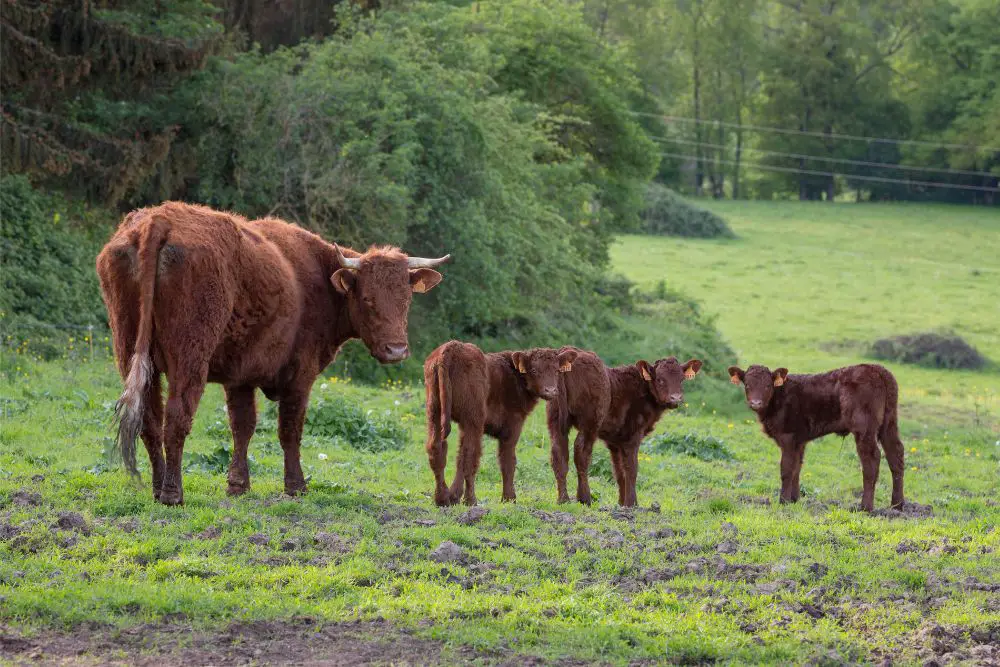Saler (pronounced sa-lair) cattle are an ancient French cattle breed known for rich milk quality, excellent meat production, high rate of reproduction, hardiness and calf vigor. They are very calm, docile and friendly to their owners.
This article will cover the history of the Saler breed, and outline the characteristics of Salers cattle, illuminating the many benefits of raising Salers.
Table of Contents
Where Does Saler Cattle Come From?
Saler cattle are from the South of France and are believed to be one of the oldest, genetically pure European breeds.
Ancient cave paintings revealed the ancestors to the Saler cattle were likely in the Auvergne region for as long as 17,000 years, and it was discovered that their genetic makeup is close to African and old Celtic breeds.
In the 19th century, a small amount of West Highland, Devons, and Durhams were imported from the U.K. to improve Saler Cattle.
Concurrently, a Frenchman by the name of M.Tyssandier D’Escous disapproved of muddying the blood of Salers and set about improving Salers by selective breeding only from Salers herds.
His method proved the more successful of the two attempts at improving the breed. He was given the honorary title of “Father of the Breed” and a statue was erected of him in the town of Salers, from which the breed got their name.
After 1925, the breed became regarded as the ideal suckler, and became known for all-season forage aptitude, the ability to survive from native grasses even in poor soil, and withstand drought conditions.
Today, Salers are the largest cattle breed in France, with roughly 210,000 head, the majority of which are still residing in the Massif Central highlands. The Saler breed is considered mostly purebred with little influence from earlier experimentation.
They have been imported to many countries throughout the world including the U.K, New Zealand, Canada, Russia, and the United States and are known as a well-balanced, profitable breed.
In North America, the American Salers Association was founded in 1974 to preserve and promote the breed. A few years later, in 1986, the Salers Cattle Society was founded in the U.K. to register Salers throughout Europe.
Saler Cattle Breed Characteristics
| Official Breed Name | Salers Cattle |
| Scientific Name | Bos taurus taurus |
| Origin | France |
| Appearance | Red Mahogany or Rich Black Coat with long, light-colored horns. Rare specimens may be polled. Excellent conformation. Black hooves. |
| Calf Weight | 66lbs to 88lbs |
| Mature Cow Weight | 1,543lbs to 1,653lbs |
| Mature Cow Height | 4.6 feet |
| Mature Bull Weight | 2300lbs to 2600lbs |
| Mature Bull Height | 4.9 feet |
| Ready To Breed | 12 to 14 months |
| Gestation Period | 280 days |
| First Calvings | 30-32 months |
| Time to Slaughter | 6 months |
| Carcass Yield | 60% |
| Expected Lifespan | 10 – 15 years |
| Productive Lifespan | 5+ Years |
| Known For | Fat-rich milk and cheese production, adaptability, dual-purpose beef production, calving ease, drought resistance, suckler breed |
| Weaknesses | Can be expensive to purchase |
| Climate | Can endure extreme cold weather and hot weather |

What Is So Special About Saler Cattle?
Saler cows produce rich, fatty milk in large quantities – approximately 6600 pounds of milk per year. This milk is used in making specialty French cheeses including L’Appellation d’origine contrôlée, St. Nectaire, Cantal, and Saler.
Yet only 9% of modern Salers are used for their milk, as the beef they provide is more profitable.
The Salers breed was selectively bred as a hard-working cow that is dual-purpose and has excellent meat that is known for its robust flavor.
It is one of the best beef breeds for natural marbling in its meat and high carcass yields. This equates to more marketable pounds increasing profits.
Saler cows also wean the heaviest calves of any breed; 660lbs for cows, and 705lbs for bulls.
Why Should I Raise Saler Cattle On My Farm?
Farmers often raise Saler cattle because:
- Saler cows have a wide pelvis and easy calving and weaning
- Shorter average gestational period, and can continue producing calves for 10-12 years
- Salers calves are vigorous at birth and immediately suckle
- Excellent foragers in highlands and mountainous terrain
- Able to withstand temperature extremes without a loss of productivity
- Primarily used for beef production as a maternal beef breed in North America
- Cows readily accept terminal sires
- Saler bulls are virile breeders and used in crossbreeding Charolais to produce veal calves
- Salers females have well-formed udders and are able to simultaneously wean and still have high milk production output (3,000 – 4,000 pounds).
- Easy to handle, quiet disposition
- Dark skin color helps avoid infections of the eye
- Salers offer the highest return of cattle breeds in feedlots
- Heifers can be crossed with Hereford, Angus, and Simmental breeds in breeding programs
- Healthy and hardy breed not known for any disease which lowers vet bills
